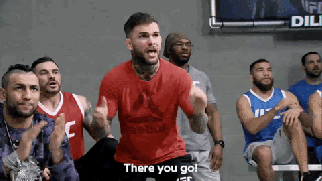To Coach or Not To Coach: That IS the Question.
Get stories like these delivered straight to your inbox
Sign up for the CultureStoke Newsletter
Well… maybe not the only question. But it’s a good place to start. Let’s get into it.
Words are fun, and the English language is hard. English is one of the more challenging languages to learn for lots of reasons, not the least of which is the copious number of homonyms—words that are spelled and pronounced the same but have different meanings. This presents challenges in all sorts of fun and interesting ways.
In my profession, and for people in leadership and/or mentorship positions, this is never more present than when it comes to the word “coaching.”
Because of that, I decided to write this article to clear the air, make things a little simpler, and most importantly, make you more effective!
In this article, we will discuss the terms for tools that a leader/coach uses, what it means to be a coach versus the act of coaching, and when to use which tool.
Let’s jump into terminology.
The Tools a Leader/Coach Uses
Supervising Defined
Supervising is relatively straightforward.
You are ensuring that people are doing the right things, correctly. A simple definition would be the observation of an individual or a group, ensuring that tasks are being done correctly, to the correct standard, and in line with the culture, policies, and procedures. Supervising involves correction when people are not performing to the standard, as well as recognition of those doing exceptional work.
It is an essential function in any organization, but unfortunately, the one that most people associate with “leadership.” As if their sole purpose was to monitor activities to ensure people remain productive and desired outcomes are achieved. As I mentioned, it is an essential function, but a foundational one.
Being good at supervising will make you an effective boss, but it will not make you an effective (or even a good) leader.
Teaching Defined
In my experience, the activity is most often delegated.
Teaching is the act of imparting new knowledge. It could be everything from teaching someone to clock in, coding a new customer interface, or writing a deposition for a case. We teach people the agreed-upon practices to help them become more successful. When was the last time you taught somebody something you knew was going to be bad for them? The qualifier here is that you are teaching people something that is not unique to you; it is knowledge that has been collectively agreed to by either the team, organization, and/or community of a way they/we should all act, think, or believe. The distinction between teaching and mentoring is small, but it is the distinction that makes it important.
Mentoring Defined
Unlike teaching, mentorship is not only the imparting of new knowledge, but also the imparting of how you (the mentor) use that knowledge, how you approach things—essentially, how you think about and do what you do. Mentorship is a deep relationship between mentor and mentee that requires a deep sense of care and trust to be beneficial because you are sharing a piece or pieces of your world with someone else in the hope that they avoid some of the mistakes you made along the way.
Here is an example of the distinction between teaching and mentoring.
We are baking a cake.
In a strictly teaching aspect, if you were to teach someone how to bake a cake, you might show them around the kitchen, show them the tools and how those tools are used, and provide them with the recipe with instructions. (Author’s note: bringing in a soupçon (süp-ˈsōⁿ) of supervising, you may watch them to make sure they are doing it correctly)
If mentoring was involved, you may do all the things mentioned above, but would come alongside and bake the cake with them. Show them how you grease the pan and mix the wet and dry ingredients. You might impart some tacit knowledge about how you find the cake's texture to be better if it is baked at 350º versus the prescribed 375º.
One approach shows how to do it, the other shows how you do it.
(Another author’s note: I don’t bake, so if any of this sounded silly, just know you are fixated on the wrong thing. This is not about cake. 🤪)
Mentoring is an amazing tool that I think is slept on by too many organizations as a mechanism to turn tacit knowledge into institutional knowledge, a great way to onboard leaders, and to close equity gaps. The final role has less to do with you (the leader/mentor) and more to do with the individual who needs you.
Coaching Defined
Coaching is one of the hardest skills to perform because it will quickly dovetail into the other roles. There is a temptation to make it about ourselves rather than the person who needs our help. Coaching is the act of helping someone arrive at their own conclusions, using their own knowledge, and helping them establish their own new neural pathways through inquiry.
Put simply, coaching is the art of asking great questions.
Nudging people to their own conclusions about their best path forward by probing their existing thoughts, assumptions, and perspectives.
“Great,” by the way, does not mean profound or even deep. Great in the sense that it pushes the person to think for themselves. Think about it…
Providing feedback… that’s supervising, mentoring, and/or teaching.
Providing advice… that’s mentoring and/or teaching.
Correction… that's supervising.
If the dialogue centers around the person and their knowledge, it is likely in the realm of coaching. The moment you start to share your world, you’re doing something else.
Being a Coach vs. Coaching: Know the Difference
Remember when I mentioned above that the English language is challenging due to homonyms (and other reasons)? Coaching is where this issue rears its head pretty pervasively because we will conflate all the tools we talked about above under the guise of “coaching.”
Coaching is a tool.
Being a coach is a role.
You might be asking yourself, “So what?” But when we conflate the role of being a coach with the tool and are not using all the tools with intention, we will always fall back on the one we find most appealing or the one we are most comfortable doing.
Put another way, not being thoughtful about which tool is needed will make us lazy and less effective coaches.
When you are someone’s coach, you need to be conscious about what tool is going to help the person grow in the way in which they need to grow. Giving them the answer is rarely the right thing in the long run.
Good coaches know how to use all the tools, great coaches know when to use them.
When to Wear Which Hat
I want to start this section with a caveat. I will be writing in generalities, not in absolutes. Situations are situational, after all.
When to Supervise
This is the easy one.
You do this when you need to make sure the ship is running smoothly, when you are measuring performance and looking for opportunities for appreciation and celebration.
Pure supervision actually requires very little interaction between you and those you are supervising unless they are a) not performing up to standard or b) are doing a good job.
If performance is off: Correct it using the right tool (teaching, mentoring, or coaching).
If performance is strong: Show gratitude—for how they work, not just that they work.
Otherwise, it's a lot of observation, and little else.
When to Teach
Teaching is typically reserved for the new.
New to the organization.
New to the team.
New to the position.
New to the industry.
New skill.
New.
Teaching is typically structured, procedural-based, and measured by compliance.
Can the person perform the duty/activity to the level that meets the qualification of “trained?”
You will want to put on your teaching hat when compliance is all that is needed, and there is no need for anything other than for them to know how to do something. Which means it is documented, agreed upon as the standard, and has definitive conditions of satisfaction.
When to Mentor
Mentorship can be distinguished by time. Teaching and supervising (even coaching, to a certain extent) can be short-duration activities with a defined start and end. In comparison, mentoring is a longer-standing, relationship-based tool. These relationships may span years depending on the complexity and the depth of knowledge required to do the work. Mentoring is one of the most complex skills for both parties involved.
For the mentor, there can be a sense of replaceability.
“If I show this person what I know, my value diminishes.”
For the mentee, there can be a real or perceived pressure to excel quickly and avoid mistakes.
“I need to prove myself, I need not to let this person down.”
Mentoring has a lot of utility, but it often gets overlooked because it does require a greater investment of time from both the mentor and the mentee.
One use case is with jobs that have a high level of complexity and variability. Things like first responders, lawyers, actors, politicians, business owners, sales, etc. Think of jobs and positions that have to have high situational awareness and the ability to be responsive to constant shifting in operational norms and situations.
Another case is for closing equity gaps. Equity gaps are the disparities in outcomes such as achievement, access, retention, advancement, and compensation in different groups. Typically along the lines of gender, race, economic status, disability, and other marginalized groups. Mentorship can be an excellent way to open doors for other people that they would not think available to them by using your access to outcomes to allow them to achieve.
Mentoring is particularly useful in cases where there is not a ton of documented polices, processes, and procedures. Organizations that rely heavily on institutional knowledge to get things done. If you have someone who has been around for a while and they are planning on leaving and plan to replace them with someone new or less experienced, mentorship should certainly be a part of the transition plan.
Any mentorship should include job shadowing with specific outcomes coupled with *scaffolded learning.
*Scaffolded learning: Commonly referred to as “See One, Do One, Teach One.” It is a method of task learning that involves the following:
I do, you watch – The experienced person demonstrates the task.
We do it together – The new person performs the task with support.
You do, I watch – The new person performs the task independently while being observed.
Mentorship smooths everything from onboarding new leaders to closing systemic disparities. It is one that pays a lot of dividends for all involved. But this tool is centered around making a person perform, think, and (in some cases) act like you. The next tool is solely for them.
When to Coach
As a reminder, I want to uncouple the role of being someone's coach (in which case you may need to supervise, teach, mentor, and coach) versus the act of coaching (asking great questions to get people to come to their own new conclusions). Let’s put the coaching hat on.
I am not going to lie to you; coaching is hard. Hard not to give away the plot, hard not to impart our own bias, hard not to make it about ourselves. What would we do? How would we approach things? How have we solved it in the past?
Coaching is all about the journey, not the destination. The learning is in the process, not the outcome.
Coaching can be short or long in duration. It can be situational or part of a mentoring relationship. In either case, what it looks like is inquiry. Questions like: “Why is that important to you?” “What do you think you should do?” “Where do you think that it's coming from?” “What would you like to see?” “How do you think you should approach that?” The goal is to get them to break out of circular thinking (validating what they already know—just looping back on the same conclusions—rather than stretching their thinking into something new) or to explore new potential pathways. Coaching is about expanding their ability to think critically, and that does not come by providing information; it is about helping them establish new connections in the brain.
I always default to coaching first. I have come to find most people have the intelligence to solve their own problems, create their own path, and/or establish their own footing. What they are typically looking for is something to give permission or provide the antidote. Coaching can help nip that permission seeking or lazy thinking in the bud. In that case, I am not helping them with the problem at hand; I am coaching them to have confidence in their own knowledge.
But, there are also instances where they truly do not have an answer. Coaching can help there, also. When someone presents you with options, help them explore them. “What do you think would happen if you did it this way?” “What are the unintended consequences of approaching it like that?” “How would that help you achieve your goal?” When someone presents you with emotions like confusion, frustration, anger, happiness, etc., but is unsure of the source, help them unpack them. “Where do you think that's coming from?” “Where do you feel that in your body?” “What is your concern/fear?”
In my experience, coaching is almost always the best place to start.
Conclusion
Being someone’s coach/mentor is an amazing privilege. They are trusting in your knowledge and experience. They are telling you they value what you have to offer.
It is also an immense responsibility. Knowing which tool to use when is a constant state of reading the room, assessing the need, and pivoting to what is going to help them in the long term. Supervising is you making sure people are doing the right things. You teach to impart your knowledge and skills. Your mentor helps a person avoid the pitfalls you encountered on your journey. You coach to make a person more aligned with their authentic self.
Supervising, teaching, and mentoring are a lot about you. Coaching is about them, and helping someone become their best self is a priceless gift.
P.S. A Word Just for “Coaches”
Coaches, I am speaking directly to you right now.
I know there is often temptation to make it about you or to shortchange the process for expedience.
Whether you are “model-dumping,” a phrase I coined for coaches/consultants/facilitators who through a desire to show how smart they are reference all the models they’ve studied or giving away the answer because they can’t be bothered to allow the person the time to think through it themselves; stop it. You have the knowledge, but the important skill for us is to know the difference between things that can be taught versus lessons that must be learned.
When I was getting started, some of the best advice I was given by a mentor was that there are going to be lots of times when you have seen the end of the movie and know what the “right answer” is, but that's not the point. The best coaches are the ones who default to allowing the person to think for themselves first. You’re there to add some color, serve as the bumper rails to make sure they don’t fall into the gutter, and encourage them when it gets hard.
You know a lot. You have seen a lot. You have grown a lot. But, we can take for granted that the stuff we know, have seen, and grown from is less important than the journey that got us to where we are.
Don’t try to shortcut others’ journeys because you think you know better; they will just become reliant on you. Remember your journey and help them along their own.







